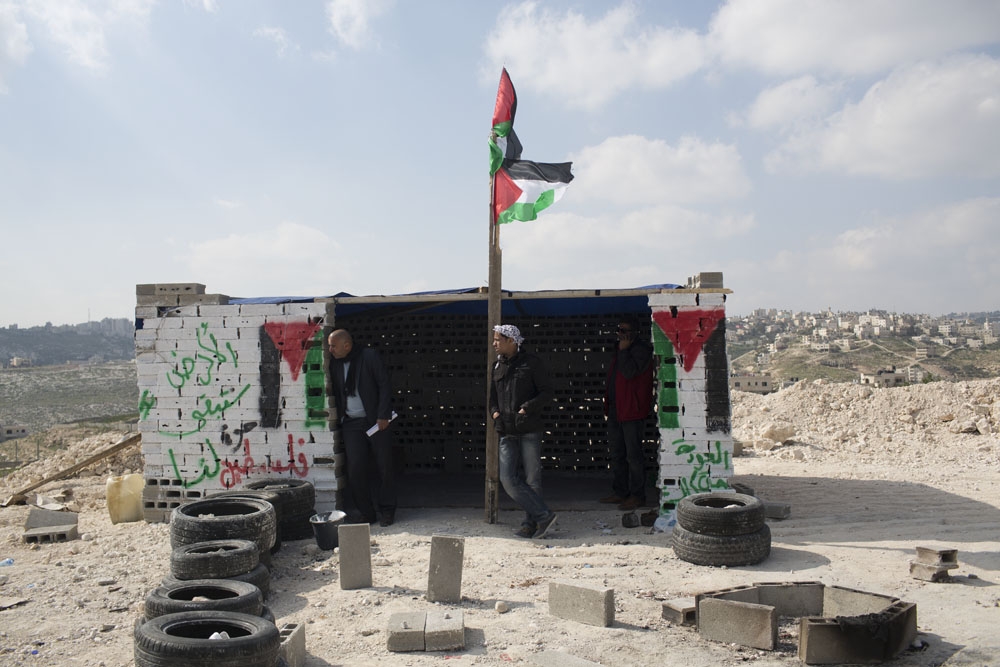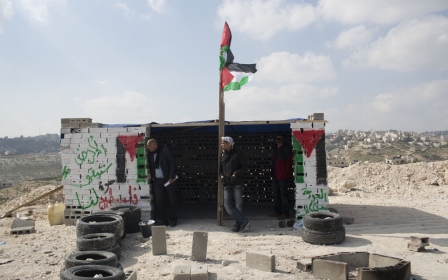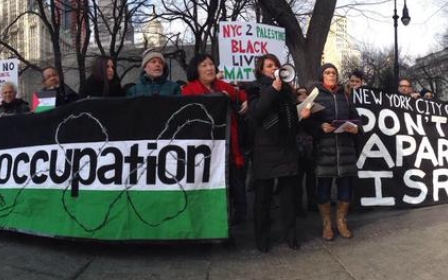Palestinians strive to oppose Israeli relocation of Bedouins

Building momentum, making progress and building permanent movements is usually considered essential for any political struggle.
But in the West Bank, going back to square one every morning is a fundamental strategy for one group of activists. In the last week a camp built by protesters on land surrounding Jerusalem has been torn down four times. And after every demolition they’ve returned, rebuilding shelters and repopulating a space for organising, gathering and demonstrating.
On Sunday evening, locals from Abu Dis, Al-Eizariya and Sawahira joined with Palestinian and international activists, community leaders and landowners to bring the camp alive for a sixth night. Participants gathered around a fire to sing and play music; others talked and ate in a simple breezeblock shelter decorated with graffiti and flags.
For many of the group, staying here is about resisting a life-changing imposition. Israeli authorities have earmarked the land the camp now occupies for a new development: a modern town where Bedouin from some 20 communities are to be forcibly transferred and rehoused.
Adel Salah, the head of the Abu Dis local council, was among several dozen people to attend the protest on Sunday night. Like many present, he’s concerned for the rights and welfare of both the Bedouin and his own community.
“I'm here protesting against the expulsion of Bedouins and the concentration of them in this area,” he told Middle East Eye. “The first thing to stress is that this plan would be harmful for the Bedouin. It takes them away from their culture, their livelihood, their history.
“The second thing is that there’s two different kinds of lifestyles here. We have here a farming society and the Bedouin society, and to have us living together here would not be good for either of us. We want to struggle against this, and to struggle together, to stop it happening.”
The fight Salah describes may not be an easy one. The Bedouin communities that Israeli authorities plan to relocate currently live in Area C – space which comprises 60 percent of the West Bank, and is entirely under Israeli control. Because the land earmarked for Bedouin resettlement is also in Area C, it can be claimed by the Israeli Civil Administration for development despite the fact it's owned by private individuals and companies.
The land under threat in this struggle, too, is of crucial strategic importance. Bedouin camps are scattered across the E1 area: in valleys below hilltop settlements, on the Route One highway and, crucially, between the city of Jerusalem and the West Bank settlement of Ma'ale Adumim. Israeli authorities plan to develop the area, and plans indicate that building will link West Bank settlements with East Jerusalem and stake an Israeli claim to the whole of the city.
Abu Imad, a leader in a Jahalin Bedouin tribe who attended the Sunday's protest camp, believes his people pose a significant obstacle for those plans. For that reason, he believes, they're being targeted systematically by Israeli authorities.
“As Bedouin, we occupy 40 percent of the West Bank, distributed all over Area C,” he explained, speaking to Middle East Eye in the protest camp's chilly shelter on Sunday. “Part of this plan is to achieve the greater Jewish Jerusalem, but it's also about canonisation of the West Bank and separating the north of the West Bank from the south. If there are no Bedouins in this Area – Ma’ale Adumim, Jerusalem, all the way to Jericho – I swear that no Palestinians will be able to get into this area without a permission.
“We know that Israel is aiming to control the land,” Abu Imad continued. “And they are planning to take as much as they can of the land – creating facts on the ground so if there’s any negotiations they’ll already have taken everything.”
If the Israeli plans go ahead, Abu Imad and his family will likely join more than 20 other Bedouin communities in the purpose built settlement between Al-Eizariya and Abu Dis, where the protest camp now stands. It will be the third time his community has been transferred from its lands: displaced to E1 from the Naqab in 1948, they were moved again to a new location, close to where the camp now stands, in the 1990s.
The repeated moves have been tough. After the last transfer, Abu Imad and his family found they did not have space to herd their 150 sheep and goats in the mountains as they had done every day. Forced to sell the animals, Abu Imad found himself with no income and 15 people to support.
Many say the planned settlement, which critics argue fails to cater to the Bedouin’s needs, could only make things worse, and attempts to force communities into the kind of modern lifestyle embodied by it are fiercely opposed.
“The house I’m living in, it’s made of stones, with a roof. Anyone who saw it would say I’m living a good life,” Abu Imad said. “But I swear, if you gave me a tent in the wilderness, or in the Naqab, tomorrow I would leave all this and live my life there. Israel creates special reserves for birds and animals, to give them freedom to live in the natural style. But they’re not permitting us to live our life as we want to.”
Israeli authorities argue that plans for resettlement are in the interest of Bedouin communities, while stressing that the structures of the protest camp were built illegally.
"Civil Administration is promoting a program to settle the houses of the Bedouin population, arranging a proper infrastructure for their homes," a spokesperson for the Coordination of Government Activities in the Territories told Middle East Eye. "The program was formulated after several meetings were held between representatives of the Civil Administration with representatives of the Bedouin community."
But at the protest camp, many activists agreed with Abu Imad that relocation plans were closely related to the broader issue of Israeli control over the West Bank. But they say the transfer could create serious local problems too. Locals this week argued that Abu Dis is becoming like a refugee camp – squeezed and impoverished, isolated from the West Bank and Jerusalem by walls and checkpoints, and lacking space for the population to grow.
“We're becoming an island, a canton,” Samer, who owns a portion of the land earmarked for the development, said. He and the other landowners say they had hoped that young people from Abu Dis could build new homes in the area: the transfer of a new Bedouin population, he explains, will put immense economic, political and social pressure on all the Palestinian communities close by.
As the moon began to rise over the Jerusalem hills on Sunday, residents of the surrounding towns and members of Bedouin communities gathered around the campfire together. Those present clearly saw their aims as closely connected.
But for the organisers of the protest, the fact that both groups are working together is something of a victory. The relocation plans, they explain, threaten to drive a wedge between different Palestinian communities if local people blame the resettled Bedouin for the seizure of their land and the potential social and economic problems that might cause.
Thaer Anis, one of the activists behind the camp, told Middle East Eye that special consideration had been given to building relationships between groups. The strategy of the camp too, he said, is different to previous villages like Bab al-Shams and Ein Hijleh, protest camps in E1 and the Jordan Valley that attracted significant attention in recent years. While these fully-functioning settlements were inhabited 24-hours a day until they were evicted by military police, being demolished and rebuilt is central to the Al-Eizariya camp’s strategy of steadfastness and consistency.
“We want to coordinate our differences, to show that the Bedouins are not going to leave their places, and the people in the village are not going to leave their land,” Anis explained. “Our strategy here builds on our experience of creating different kinds of villages. We wanted a strategy that meant it wasn’t possible to destroy it like the ones before.
“We are slowly working on building and consolidating the willingness of the people to resist,” Anis continued. “We don’t want this to be something that just gets destroyed – we want it to be continuous.”
Abu Imad will keep coming back to the protest as it is rebuilt day after day. For him and his family, a great deal rests on the camp’s ability to reinvent itself every time it’s demolished.
“We are part of the Palestinian people, we’re deep rooted in our Palestinian people, we’re making very big sacrifices in our struggle, just like the rest of the Palestinian people,” he told Middle East Eye. “The future is very dark. But in spite of the darkness, we have hope in the future – and we must keep hold of this hope.”
Middle East Eye propose une couverture et une analyse indépendantes et incomparables du Moyen-Orient, de l’Afrique du Nord et d’autres régions du monde. Pour en savoir plus sur la reprise de ce contenu et les frais qui s’appliquent, veuillez remplir ce formulaire [en anglais]. Pour en savoir plus sur MEE, cliquez ici [en anglais].





